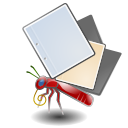Japanese
These files contain:
A full set of JLPT Level 1 vocabulary, originally taken from the Japanese Flash Cards for Mnemosyne set and extensively revised based on practice and actual Level 1 exams.
A partial list of JLPT Level 1 grammar structures, with definitions and examples culled from WWWJDIC and the Internet.
This list contains over 1000+ common Japanese words and Kanji, and should take you from beginner to intermediate level. The list is based from the material that is used in the Japanese classes taught at Waseda, University in Tokyo.
The original list was first published on Japanese Words in Xcel format can be found at:
common Japanese Words
You can contact me with any questions at: http://www.japanesewords.net/contact/
JPLT Levels 4 and 3 Vocabulary and Expressions, complete and verified, based on the official JLPT Test Content Specification (2004).
* 748 Level 4 cards: 727 vocabulary + 21 expressions
* 692 Level 3 cards: 681 vocabulary + 11 expressions
In June 2010, nearly 200 new kanji have been officially added to the joyokanji list.
In this learning file you can find the new ones.
Question: Kanji Answer: Reading
Question: Reading Answer: Kanji
This one file contains all kanji of the joyokanji list.
The different gakushu levels are indicated by categories.
Question: Kanji Answer: Reading
Question: Reading Answer: Kanji
These four files contain all the words necessary for the JLPT examinations, level 1-4.
Question: Kanji Answer: Reading
Question: Reading Answer: Kanji
These four files contain all the words necessary for the JLPT examinations, level 1-4; Japanese-German.
Question: Kanji+Reading Answer: German
Question: German Answer: Kanji+Reading
Vocabulary for Japanese: The Spoken Language textbook series (JSL, Books 1, 2, and 3) by Jorden and Noda.
Contains 2714 vocabulary items, covering all lessons (1–30), essentially complete, only omitting certain regular counters and breakdowns from Book 1.
This is a flashcard set for all 214 radicals of Sino-Japanese script, as described in classic Chinese Kangxi dictionary (http://en.wikipedia.org/wiki/Kangxi_Dictionary).
Primary intent behind this pack is to help people learn Japanese Kanji/Chinese characters, by allowing them to visually decompose each character into its constituent radicals, and thus memorize characters not by strokes, but by big and meaningful stroke groups, which eases the task immensely.
Katakana, symbol-to-reading and reading-to-symbol. Includes dakuon and handakuon versions and youon (combinations). All cards are accurately tagged to allow you to study or rehearse only specific subgroups. The reading side mentions that the katakana is expected, so you can combine these cards with hiragana without worrying about duplicates.
